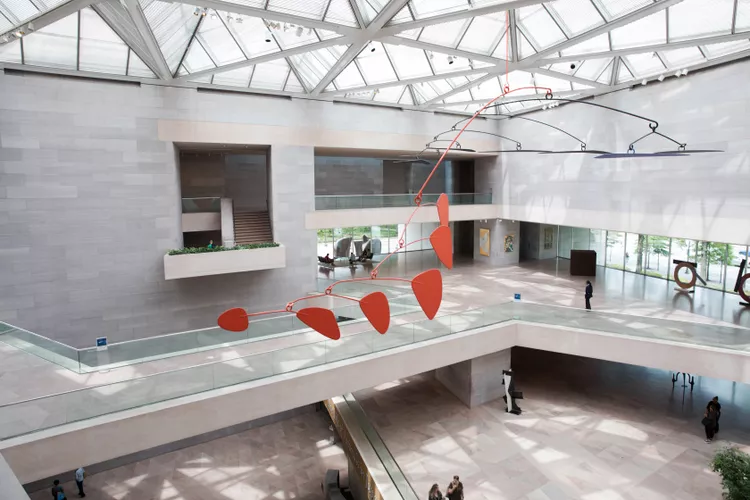Summary
The National Gallery of Art in Washington, DC, is a remarkable art museum renowned for displaying one of the largest collections of masterpieces in the world. It encompasses paintings, drawings, prints, photographs, sculptures, and decorative arts from the 13th century to the present day. The collection features an extensive survey of American, British, Italian, Flemish, Spanish, Dutch, French, and German art. Located on the National Mall and surrounded by the Smithsonian Institution, visitors often assume that the museum is part of the Smithsonian. However, it operates as a separate entity and is funded by a combination of private and public sources. Admission to the museum is free, and it offers a diverse array of educational programs, lectures, guided tours, films, and concerts.
What Exhibits Are in the East and West Buildings?
The original neoclassical West Building showcases European (13th-early 20th century) and American (18th-early 20th century) paintings, sculptures, decorative arts, and temporary exhibitions. In contrast, the East Building features contemporary art from the 20th century and houses the Center for Advanced Study in the Visual Arts, along with a large library, photographic archives, and administrative offices. The East Building gift shop has been completely redesigned to feature a new assortment of reproductions, publications, jewelry, textiles, and giftware inspired by both 20th- and 21st-century art as well as current exhibitions.
Address and Hours
Located on the National Mall at 7th Street and Constitution Avenue, NW, Washington, DC. For inquiries, call (202) 737-4215. The nearest Metro stations are Judiciary Square, Archives, and Smithsonian.
The museum operates from Monday to Saturday, opening at 10:00 a.m. and closing at 5:00 p.m., and on Sundays from 11:00 a.m. to 6:00 p.m. Note that the Gallery is closed on December 25 and January 1.
Visiting Tips
- Review the exhibit map in advance to ensure you have ample time to explore the galleries that pique your interest, as this is an extensive museum with much to see.
- Take the underground walkway between the West and East buildings, where you can admire thousands of twinkling LED lights that make this passage a work of art.
- Consider attending special events, films, concerts, and take advantage of the many free educational programs offered.
- Visit the Gallery Shop, which boasts a delightful selection of gifts, including reproduced prints of famous artworks.
- Stroll leisurely through the Sculpture Garden to enjoy one of the best outdoor venues in the city.
- Three cafés and a coffee bar provide a variety of dining options.
:max_bytes(150000):strip_icc():format(webp)/VDC_9306-c848475ea5b747029c778b33443fe925.jpg)
Outdoor Activities
The National Gallery Of Art Sculpture Garden encompasses a six-acre area on the National Mall that serves as an outdoor venue for art appreciation and summer entertainment. Additionally, during the winter months, the Sculpture Garden transforms into a site for outdoor ice skating.
Family Programs
The Gallery hosts a continuous schedule of free, family-friendly activities which include workshops, special family weekends, concerts, storytelling programs, guided conversations, teen studios, and exhibition discovery guides. The Film Program for Children and Teens strives to showcase a diverse range of newly produced films appealing to both youth and adult viewers while promoting an understanding of film as an art form. Families can explore the collection together through a children’s audio and video tour that highlights 50 masterpieces displayed in the Main Floor galleries of the West Building.
Historical Background
The National Gallery of Art opened its doors to the public in 1941, backed by funds from the Andrew W. Mellon Foundation. The initial collection was amassed by Mellon, who served as the U.S. Secretary of the Treasury and ambassador to Britain in the 1930s. He collected numerous European masterpieces, many of which were once owned by Catherine II of Russia and acquired in the early 1930s from the Hermitage Museum in Leningrad. The National Gallery of Art’s collection has consistently expanded, leading to the addition of the East Building in 1978, showcasing 20th-century contemporary art, which includes works by celebrated artists like Alexander Calder, Henri Matisse, Joan Miró, Pablo Picasso, Jackson Pollock, and Mark Rothko.




